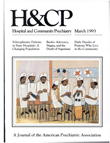Correlates of Patterns of Substance Abuse Among Patients With Schizophrenia
Abstract
Most previous research on substance abuse among patients with schizophrenia has not considered the types of substances abused or the confounding influences of polysubstance abuse. The authors' goals were to identify patterns of substance abuse among a sample of subjects with schizophrenia and to determine demographic and clinical correlates of these patterns. Methods: Subjects with schizophrenia were identified from the Epidemiologic Catchment Area study data base, which also provided information on the types of substances abused and on selected demographic and clinical characteristics. Latent class analysis was used to group subjects based on their patterns of substance abuse. Logistic regression was used to identify demographic and clinical correlates of the patterns. Results: Three latent classes based on patterns of substance abuse were identified: no substance abuse, abuse of alcohol and cannabis, and polysubstance abuse. Subjects with either of the two patterns of substance abuse were more likely to be younger and male and to have depressive symptoms. Conclusions: The results do not support a link between abuse of specific substances and specific clinical symptoms but do suggest a general link between substance abuse and affective disturbance among schizophrenic patients.
Access content
To read the fulltext, please use one of the options below to sign in or purchase access.- Personal login
- Institutional Login
- Sign in via OpenAthens
- Register for access
-
Please login/register if you wish to pair your device and check access availability.
Not a subscriber?
PsychiatryOnline subscription options offer access to the DSM-5 library, books, journals, CME, and patient resources. This all-in-one virtual library provides psychiatrists and mental health professionals with key resources for diagnosis, treatment, research, and professional development.
Need more help? PsychiatryOnline Customer Service may be reached by emailing [email protected] or by calling 800-368-5777 (in the U.S.) or 703-907-7322 (outside the U.S.).



